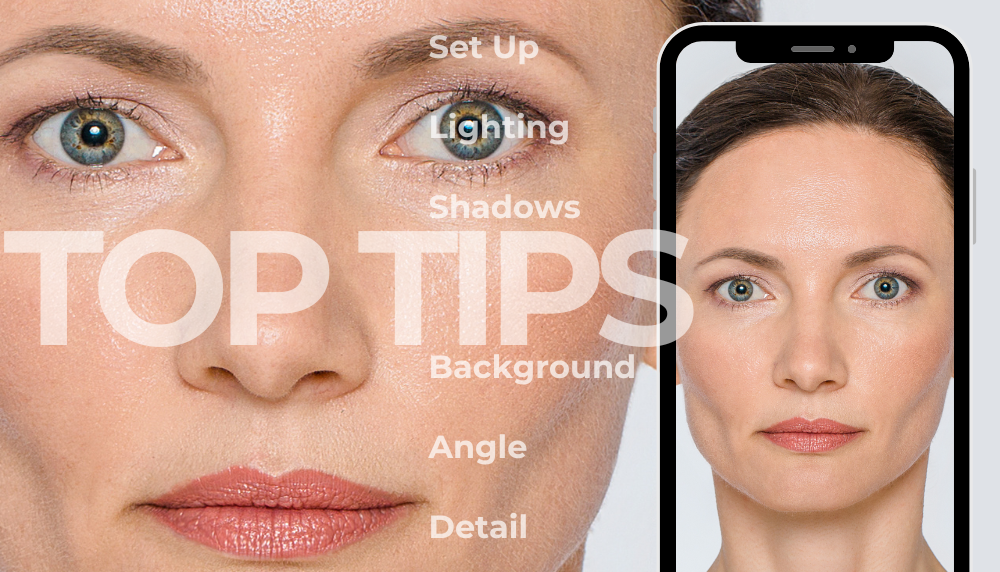Professional-level photography is fundamental to the success of any appearance medicine clinic. Cosmetic and plastic surgery clinics need to concisely capture incremental improvements in skin or body to show new and returning clients how aesthetic procedures can transform their appearance.
Effective photographs can be used for treatment planning, pre and post-procedural comparisons (before and after galleries) and patient education. In terms of benefits, effective photographs drive sales. A RxPhoto survey of 1,000 potential aesthetic surgery clients found that 74.8% would not even consider a practice that didn’t have high quality photographs for patients to peruse.
Fortunately, today’s mobile devices (iPhone, iPad, tablet) offer quality that is comparable to that of a professional level DSLR camera, but with the ease of using a mobile device. If you want to learn more about DSLR cameras in comparison to mobile devices with regard to plastic surgery photography, you can weigh up the benefits and disadvantages here.
If you’re already using a mobile device to capture patient photographs, or you’re thinking about it, read on–we’ve included a range of helpful pointers to help you uplevel your photography even further with simple adjustments to lighting, color, backgrounds, and detail.
Lighting: How to Get It Right
The importance of consistent, bright illumination and an evenly-lit space cannot be emphasized enough. First and foremost, lighting on the client must be uniform. Inconsistent lighting can veil, obscure or detract from treatment progress.
Here are some of our recommendations for improving the light in your photographs:
Be aware of how natural light impacts images
The lighting in a room is immensely affected by the natural light outside. Colors fluctuate and appear warmer in the early morning or late afternoon light due to the low angle of the sun.
If you photograph a patient in the morning and their next photo is taken in the afternoon, the photographs will be significantly different, impacting on the uniformity of the images. It’s difficult for clients to compare images that have clearly been taken under different light conditions.
Factor in natural light changes by converting a windowless room in your office into a dedicated photography room, thus eliminating any alterations in natural light which will affect the photograph. However, in a busy office with high movement of patients, there could be logistical issues with multiple clients requiring photographs at the same time.
Purchase a blackout shade. For minimal investment, blackout shades provide maximum return. Blackout shades create conditions that mimic a photography studio by providing maximum light blockage and consistent indoor lighting. Each consulting room can easily be fitted with blackout shades, thus creating multiple rooms suited to taking patient photographs.
Сolor temperature
Color contributes to the overall appearance of an image and is measured in units called degrees Kelvin (K). Light bulbs that produce ambient yellow light have a color temperature of around 2700K. While this color is perfect for landscape photographs, it is unsuitable for clinical photographs as it distorts the skin tone.
As the color temperature increases from 3,000K, the color of the light appears yellow and more white. Temperatures over 6,000K are referred to as cool colors (the photograph will appear to have a bluish-white tinge). The color temperature of daylight varies, but is often in the 5000K to 7000K range.
A color temperature of 5000K is ideal for medical photography as it gives the perception of daylight with white light, capturing subtleties and details in the photograph with clarity. Take a look at this helpful color guide:
Source: LED Color Chart. Retrieved from
http://www.epanorama.net/newepa/2011/12/23/fundamentals-led-color-chart/
How to optimize lighting
Studio-quality lighting does not happen by chance. The best photographs are a product of careful manipulation and consideration of light sources to achieve a well-illuminated image .
Light can come from different sources, including overhead lights, speedlights, ring lights and diffusers. Here’s what you need to know about each:
Overhead lights
If you rely on overhead lighting in your clinic as your main light source, choose lightbulbs with color temperatures of 5000K or more. Aim to have a light fitting that broadly diffuses light: The broader the light source, the more even the light illumination, which helpfully fills in shadows.
Also be aware that the closer the light source, the softer the light. Photograph patients as close as possible to the source of overhead light. The closer the patient is photographed to a light, the more illuminated the subject will be in relation to the light source. This means it’s easier to clearly capture details.
However, overhead lighting is paradoxical as proximity to the light source also increases the likelihood of shadows occurring. The light is brightest on the upper aspects of the person’s head, which creates shadows under the nose and chin as the light falls over the face. Balancing these two variables can be challenging, and for this reason, having an additional source of light or lights on the patient is essential as it will eradicate shadows and brighten the image. Read more below to find out about supplementary sources of light.
The flash
The flash on your device represents another instant source of additional light. However, flashes should only be used as a last resort, as they can overexpose and flush images with ultra bright light, muting subtler details on the skin such as fine lines and blemishes or variations in skin color and tone. If you need to capture photographs for facial rejuvenation or resurfacing procedures, it is best to avoid using a direct flash when taking the photo. Soft, diffuse and even lighting will allow you to capture facial redness and pigmentation. There are other, more sophisticated alternatives, such as ring lights, speed lights, and softboxes that can do a much more effective job of providing light.
Speedlights
Speedlights are larger light units that can be used to flood the photograph with even white light that is ideal for clinical photographs. Speedlights provide both an enhanced and more abundant source of light in your photographs, offering the quality of light you would expect to find in a professional studio. Best of all, speedlights are relatively easy to use: You can even purchase wireless devices that synchronize them to your iPhone or tablet for straightforward use (see here, for example).
Speedlights can be used in conjunction with diffusers to help make the light appear softer and more natural in the image.
Ring lights
Ringlights are a photographic tool commonly used for portrait photography that disperse uniform light (in a ring shape) from the camera around a person’s face. This even dissemination of light is created by a flash tube is wrapped around the camera lens.They are an excellent way to achieve even light in images and eliminate shadows, particularly for photographs where skin is being captured and portraying subtle details is paramount.
These days, ring lights are incredibly popular because they can be easily fixed and synced to your iPhone or device, dramatically improving the quality of lighting with minimal fuss. They can also be used with a diffuser to soften the light as it is emitted from the flash, although that’s not necessary.
Softboxes/diffusers
Softboxes diffuse the flash of a ring light or speedlight and convert the harsh light from the flash into a broader, softer, more even light. Furthermore, softboxes reduce shadows. There are also octaboxes with eight sides, which provide very even light coverage especially suited to portrait photography. Unfortunately, softboxes are not appropriate to use with overhead light sources.
If you’re looking to achieve before and after photographs with a natural feel (as opposed to a bright, clinical feel) softboxes or octaboxes may represent a good investment. You can also purchase portable or folding softboxes for easy storage.
Setting up your space to optimize lighting
Beyond devices that help to support or manufacture studio-quality light, it’s also essential to set your photography space up to create professional-looking images.
Here are some tips for an easy, effective set-up:
- A blue, gray or black backdrop (see notes on selecting the perfect background below).
- A position marked on the floor, or a floor mat for the client to stand on that indicates the spot with the best illumination.
- The device set up directly in front of the subject. You could use a portable stand to fix the position of your iPad or iPhone.
- If you’re using additional lighting, here’s a simple suggestion for set up:
- Attach a ring light to your device. Ring lights offer the quickest and most space-effective method of achieving well-lit images with minimal fuss. Ideally, the light source should be stationed parallel to the subject at the level of the face to flush the photograph uniformly with light. The image above presents the ideal set-up of a ring light fixed to an iPad.
- If using a speedlight rather than a ring light, it is best to use it with a diffuser so the light is softened as it disseminates.
Tips on background
If you want to improve the professionalism of your clinical photographs and create a consistent before and after gallery, investing in a quality backdrop can offer incommensurate gains. Ideally, your backdrop should be
- Non-textured
- Non-reflective (for example, oil-based gloss wall paint causes reflections in flashes)
- Monochromatic or one consistent color, such as black, gray, or blue
White or blue panels on walls or the backs of doors can represent an easy place to fix a permanent backdrop. You can purchase panels or roll down shades to fasten to the back of the door or wall where you take your photographs of clients. Having a fixed designated place in the clinic for photography with the same background also helps create a sense of uniformity.
Another effective background option is a collapsible chromakey background. Specifically designed for photography, this backdrop can be hung on the back of a door for when photos are being taken, then neatly and easily stored away when you are not using it.
Sheets or drapes are inappropriate as backdrops as the undulations in the fabric show wrinkles and shadows, detracting from the photograph. Another common issue that severely affects photo quality is using different backgrounds in photos. For example, photographing a client in front of a laser or the wallpaper of the exam room shifts the focus from the patient and the clinical image to the background, which will often also cast irregular shadows.
Standardized backgrounds are simply more professional, more effective, and guarantee uniformity in your photographs. Most digital cameras use a computer weighting system that will focus partially on the subject and partially on the wall behind them, blending the distances and focusing on neither. A neutral background places the camera’s focus almost entirely on the patient.
When it comes to background colors, the three most appropriate and effective shades are blue, black and gray. Here are the pros and cons of each:
Eliminating shadows
Shadows are caused by unevenly distributed light and can detract from the focus of the photograph. If you can see a shadow in the viewfinder, rest assured there will be a shadow in the shot.
Here are some tips on eliminating shadows from your images:
- Check for shadows under the nose and neck for photographing and reposition the lights if necessary to eradicate them.
- Check for shadows cast on the backdrop. If there are shadows, these can often be eliminated by moving the subject further away from the backdrop. Twelve inches distance between subject and backdrop is recommended to minimize these shadows occurring.
The use of an additional flash unit with your iPhone or iPad can make a tremendous improvement to the lighting in the quality of the photographs you take if your office has dark corners, shadows or a lack of natural light. Used in conjunction with soft-boxes, you can almost entirely eliminate any shadows or at least dramatically minimize them to the point they’re barely noticeable.
Attention to detail
Small and seemingly inconsequential details make a significant in professional clinical photography. Paying attention to the way in which the patient’s hair, makeup and jewelry impact on the photograph will help ensure you achieve more standardized and competent images.
- Hair should be tucked away or tied back in such a manner that no facial features are obscured. Any stray strands of hair need to be pinned away from the face, or tucked behind the ears. Having some hair clips, ties or bobby pins on hand can be useful.
- Make-up should be removed prior to the photograph, particularly for patients who have undergone dermatological procedures. Obviously, make up will obscure any gains or improvements made as a result of laser resurfacing, microdermabrasion or skin rejuvenation treatments.
- Jewelry can be distracting and detract from the focus of the photograph so should be removed.
- Garments or accessories such as brightly-colored scarves that impact on the visibility of the area being photographed should also be removed prior to the patient’s photograph being taken. In addition, such pieces can affect the uniformity of images that show response to treatment over time. As much as possible, strive for consistency across the series of photographs that you take. This will ensure your before and after gallery is that much more striking.
- Use picture cropping to draw the viewer’s eye to the part of the body or face you want to focus on. For example, in the image below showing before and after of a dark circle undereye treatment, the focus is drawn immediately to the eyes. Cropped images can also help protect the client’s identity.
Taken from: https://www.ncbi.nlm.nih.gov/pmc/articles/PMC4924408/
Pixels
Pixel is a contraction of the term ‘picture element’. A pixel represents the smallest element of a digital image as digital images are composed of tiny squares, similar to a tile mosaic on a kitchen wall. Although digital photographs appear to be smooth and continuous, they are in fact a composition of millions of tiny squares or pixels.
The latest iPhone 14 Pro, for example, boasts a 48-megapixel lens and has a special “ProRAW” toggle to enable 48 megapixel photographs. These 48 MP images create image quality that rivals real DSLR camera detail. However, they can also quickly take up a lot of space on the phone, so 48MP images are only enabled when the user manually adjusts the toggle. When the toggle is off, the camera bins pixels together in groups of 4, resulting in 12 megapixel photographs that boast improved lighting.
Opting for an iPhone, android or tablet with advanced lenses, such as the iPhone 14 Pro, means your clinical photographs will achieve a greater level of detail than much older device models.
Conclusion
Standardization is critical to producing consistent, striking and professional photography. For clinics that do not have the luxury of a dedicated photography room, the addition of several inexpensive tools and application of some simple tips can go a long way in improving and standardizing your client images.
Purchasing a collapsible chromakey background, blackout shades for windows and a ring light, for example, will dramatically improve the quality of your photographs. If a standard protocol is set in place, a trained assistant can finish photographing the patient in all the required angles in as little as 3 minutes.
It may take a little effort in the beginning, but setting up your consultation room spaces to facilitate high-quality photography is worthwhile investment, which will ultimately serve you by drawing in more clients. And remember–almost 75% of potential aesthetic surgery clients won’t even consider practices without high-quality before and after galleries!
You Might Also Like
In this episode, host Audrey Neff interviews Dr. Mark (Swers) Swierczewski, a dentist by trade and owner of Luminescence Medical Esthetics. Dr. Swers shares his journey from dentistry to medical…
Uncover the importance of your Google Business Profile, your Google reviews, plus the biggest mistakes practices make with their online reputation strategy and how you can avoid these pitfalls in…
It can be up to 2-6x more to acquire a new patient than it is to retain an existing one and 80% of a practice’s revenue will typically come from…




